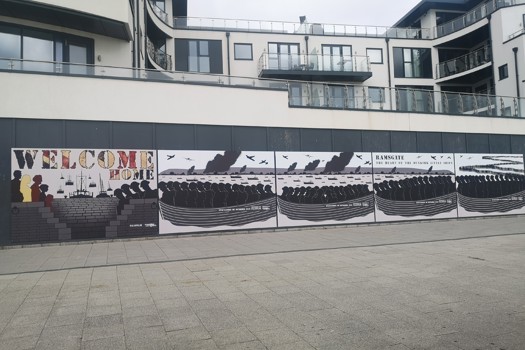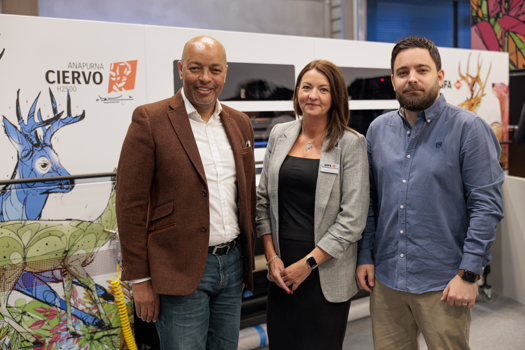My first encounter with John Gilmore, Autobond managing director, was on the top deck of a big red double-decker bus. It formed part of his Ipex stand and Gilmore insisted that every visitor tried the homemade sausages he was cooking on the top level. So when I visited the Autobond factory in Derby almost a year later I half expected to be greeted by Gilmore in an abattoir-style apron sharpening his knives. Thankfully, I found a small yet slick operation that still manufactures all its machines here in the UK, and remains firmly a family-run business.
Gilmore and his father set up the firm almost 30 years ago in a small garage behind where the factory stands today. It has been a forerunner in the movement to bring laminating in-house thanks to its affordable and highly successful Mini range, of which the 100th unit was shipped just last month. Northprint will be the platform at which Autobond’s latest offering will appear, the Mini 105 or, to give its full title, the Mini 105 TPHS (Thermal, Perfector, Heidelberg, Stacker).
This new launch will be the largest in the Mini range and can be used for landscape B1 sheet size lamination. “In its simplest form, the 105 is the Mini 76 turned on its side,” says Gilmore. “The new Mini means that you can laminate along the same grain as the sheet was printed. This allows for easier and flatter lamination.”
Both the single-sided and perfecting models run at 5,000sph (60 sheets per minute), with a footprint of 2.8x1.8m. The 105 can apply matt or gloss OPP and acetate film onto stock from 90gsm to 650gsm thick. The basic machine on its own will be £68,000 with the perfector costing £10,000 and the stacker included for another £17,000.
Solid structure
The way that Autobond manufactures its machines means that retrofittable upgrades, however far apart in time, will nearly always be possible. “What sets our machines apart from much of the competition is the 30mm thick steel side plates,” explains Gilmore. “This framework is exactly the same on all the Autobond machines, which means that when products are assembled, it can be done with ease and to a solid and reliable standard that has worked for customers time and time again.”
Almost every Autobond laminator is put together using a combination of imported parts and parts from the UK. The most popular feature with customers is the Heidelberg feeder. “The feeder is the heart of the machine,” says Gilmore. “People know and trust the name and operators are often already familiar with these feeders so they can adjust to them quickly.”
The electronics are Siemens, the clutches are Horton, the pistons are from Japanese firm FMC and the water heaters are brought in from Switzerland. Gilmore says that they once used to source all the components from the UK, but that is no longer possible and, instead, they have spent years finding the best parts to make the strongest possible end product. “Our water heaters, for example, are now stainless steel and do not rust. We have found success with the parts we now bring together and I always say ‘if it ain’t broke, then don’t fix it’.”
Digital differences
Although many of the components may come from overseas the assembly and main manufacturing processes is undertaken at Autobond’s Derbyshire factory by its 28-strong team. From this modest rural factory, machines are shipped out to customers in more than 145 global locations.
Gilmore has big plans for the latest addition to the family and if his predictions come true, the new 105 laminator will become the firm’s biggest seller. “We have not showcased it or even made a brochure yet and I am already working on five orders,” he explains.
The 105, as with all the Minis, can be used for laminating traditional and digitally printed sheets. Lamination can be more difficult with digital work as the oils used in the toner can make it harder for the adhesive to stick. The stock also tends to get dryer and more static. With these machines, there is nip pressure of up to nine tonnes, which forces an extremely strong bond even on digital.
Hot water, which generates heat to activate the adhesive, will also reach temperatures of up to 140°c. In general, a lightweight stock will need temperatures of only 80 to 90 degrees, but digitally printed or thicker stocks will need much higher temperatures. Similarly if an aqueous solution has been used during printing higher temperatures may be required.
For those bringing laminating in-house for the first time, Autobond offers up to a week’s training, although the general operation of the machines can be taught in a much shorter timescale. With the different types of print and coatings used today the training can help to clear up any teething problems that may occur.
The makeready times on the laminators should be no longer than around five minutes. “I have seen it done much quicker by a man in the US,” recalls Gilmore. “We timed him and he managed to change the film in just 50 seconds.” Diagnostics can also be done very fast via modems and the day I visited, a problem had just been solved this way on a machine in Australia.
Other laminators
The Mini 105 won’t be the only machine Autobond will launch this year. It has just finished final tests on a Mini ATPW (Aqueous, Thermal, Perfector, Window). This will be able to perform the niche operation of window lamination but can also be used as a regular thermal laminating machine. The Mini TPE will also make its debut this year, which will be able to perform micron encapsulating, as well as single sided and double-sided thin film lamination.
The modular manufacturing methods at Autobond means that there is always likely to be new concepts launched and for customer-specified customisation and upgrades. “It has been known for a customer to completely change their mind on the model they want halfway through the assembly process,” says Gilmore. “The way we work, though, means this is not a problem.”
This means that the factory floor is kept very busy, although during my visit one of the engineers was building quite an impressive jungle gym out of spare parts for Gilmore’s children – I was assured that this is only in his free time, however. I was also assured that along with the new Mini on Autobond’s Northprint stand will be a brand new batch of Derbyshire’s finest sausages.
SPECIFICATIONS
Max Sheet Size 1,050x760mm
Min Sheet Size 210x297mm
Max Speed 60m/min (5,000sph)
Stock range 90-650gsm
Price
• Basic machine £68,000
• Stacker option £17,000
• Perfector option £10,000
Contact Autobond 01773 530 520 www.autobondlaminating.com
THE ALTERNATIVES
Tauler Printlam Digital
The machine has an automatic sheet feed via a pneumatic action head, pressure rollers for film coating, traditional offset and digitally printed sheets and a polypropylene marker wheel that ensures sheet separation. A new B2 version that will be able to handle larger sheet sizes will be on the Friedheim stand at Northprint.
Max sheet size 520x580mm
Min sheet size 200x250mm
Max speed 30m/min
Stock range 110-600gsm
Contact Friedheim International 01442 206 100 www.friedheim.co.uk
Paperplast Dry 40/76
A fully automatic sheet-to-sheet laminating machine with a separator that has an anti-curl bar and a delivery table, the Paperplast has a film trimmer, trim removing unit, brushless motors and digital drives. There is also the option of a fully automatic stacker. It can be used with any thermo-welding film on the market both gloss and matt.
Max sheet size 760x1,020mm
Min sheet size 210x250mm
Max mechanical speed 40m/min
Stock range 115-500gsm
Contact Prime Print Finishing 020 8390 6798 www.primemachines.co.uk
GBC Saturn 8556
Operator-friendly touch-screen controls and adjustable timing mechanisms allow consistent registration on the Saturn. The loop water-heated chrome rollers also give consistent temperature control with the bow rollers eliminating any wrinkles in the film before lamination.
The air shaft brakes have Auto-Brake and Auto-Tune
modes, which automatically maintains tension along a whole roll of film.
Max sheet size 1,120x1,420mm
Min sheet size 280x430mm
Max speed 75m/min
Stock range 115-350gsm
Contact GBC 0800 894 373 www.gbceurope.com







